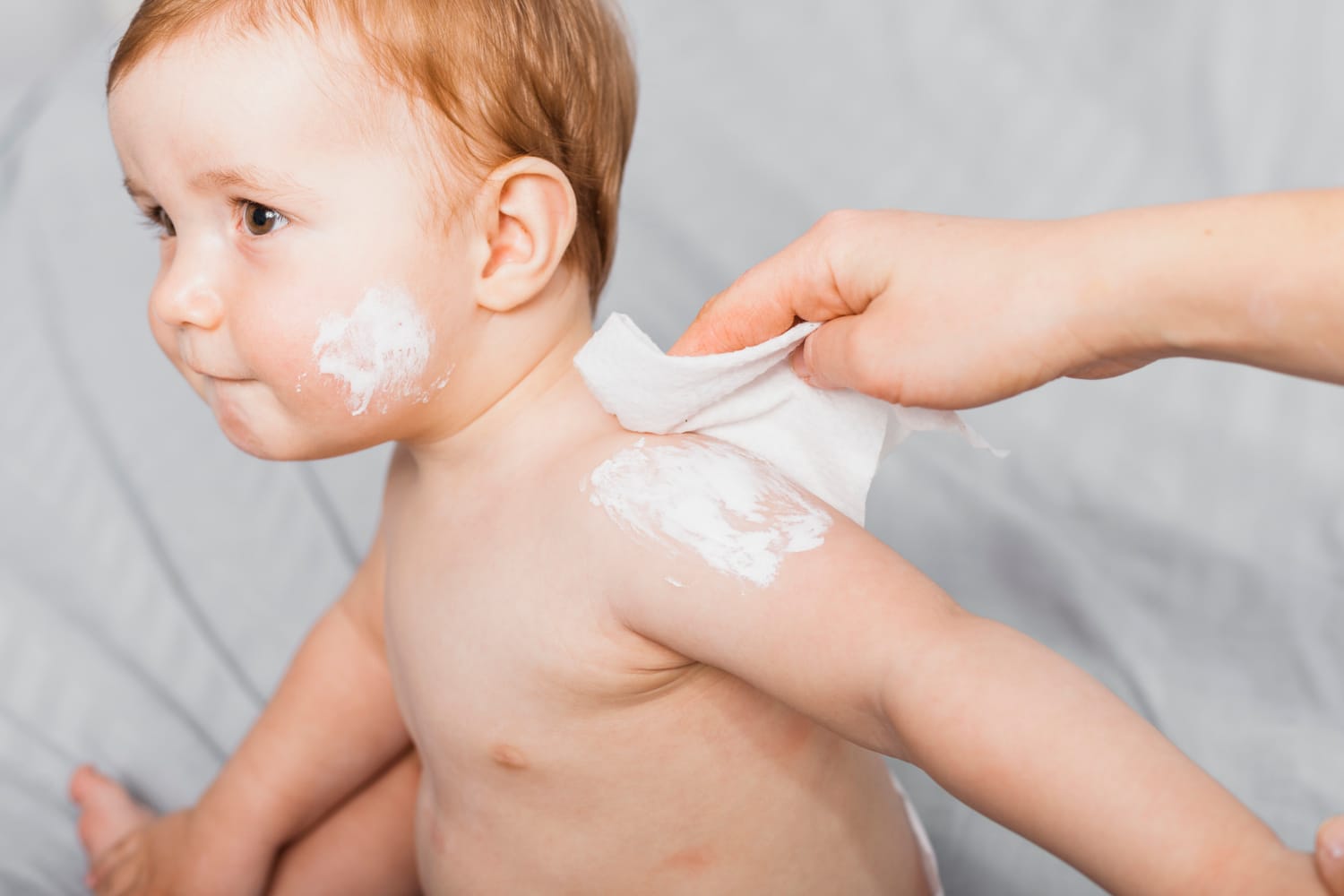It’s important for you to know that there is a range of normal characteristics in newborn babies. Some babies come into the world looking picture-perfect, whereas others resemble little aliens at birth. If your baby doesn’t look quite how you envisioned right at birth, don’t worry. Soon after, she will be as beautiful as you dreamed she would be.
Due to the limited space of the womb, as well as the effects of labor and delivery on her, your baby may have a wrinkled forehead, a flat nose, and even folded-over ears. All of these appearances are normal. Her head may also be a bit misshapen, and her eyes may be a bit swollen. She will have a “cheesy” substance all over her body called vernix, and she may have hair on her back, shoulders, and ears.
Although all of this may sound anything but attractive, these findings are normal and temporary. So you know what to expect, here are some common findings you may see in your newborn.
Head molding: This refers to the fact that all the bones of the baby’s skull can overlay or slide past one another. The bones of the skull do this to allow the baby’s head to mold to the birth canal for easier passage. This is why many newborn infants have somewhat cone-shaped heads.
These overriding bones can often be seen and felt as ridges on the scalp. They are normal. Over the first few weeks of your newborn’s life, as his head starts growing, this issue will resolve itself.
The “soft spot”: Many people have heard that babies’ heads have a soft spot. What most people don’t know is that there are actually two soft spots in newborn infants’ heads. The main soft spot is also called the anterior fontanel.
This is the larger one at the top of your baby’s head. There is also a smaller one located at the back of the head, called the posterior fontanel.
You may have heard that you shouldn’t touch your baby’s soft spot because it might cause harm to your infant. Generally, this is not something you need to worry about. Although the soft spot feels open, it’s actually covered by a thick fibrous sheet that is quite strong and protective. As a pediatrician, feeling the fontanel is the very first thing I do when examining an infant. If you look closely at your baby’s soft spot, you may see it pulse up and down with your baby’s heartbeat. Some people will also tell you that you can check whether a baby is dehydrated by feeling the soft spot, but I don’t recommend that. Feeling soft spots is not terribly accurate, especially for laypeople. If you’re concerned that your infant may be dehydrated or that the soft spot is sunken, too big, or bulging outward, the best thing to do is ask your pediatrician.
Caput: This is swelling, usually at the crown (top) of the head. It’s caused by fluid being pushed into the scalp during labor. Once your infant is born, the fluid usually absorbs soon thereafter, and the swelling resolves. Until then, the swelling is neither painful nor harmful.
Cephalo-hematoma: This is a collection of blood under the scalp that occurs from the baby’s skull bones rubbing against Mom’s pelvic bones in the birth canal during labor. Sometimes, it can also result from the use of a vacuum assist device during delivery.
This blood collection feels like a little bag of fluid, and it is often found on the side of the skull. The cephalo-hematoma may get a bit bigger over the first few days but will usually resolve over one to two months as the blood is absorbed. Rarely, a hard “bony” knot may be felt months to years after, if the cephalo-hematoma “calcifies” (gets hard like bone). If that happens, it will get smaller as the baby’s head grows. It will also soon be hidden by hair.
Scleral hemorrhages: Small collections of blood that can be seen in the white parts of the eye, caused by the pressure of labor popping tiny blood vessels in the eye. These are painless and usually resolve on their own within a few weeks. See the chapter on eyes for more information.
Scalp hair: Scalp hair is often dark at birth, and will start to shed after about a month. There are many possible
shedding patterns: your baby may replace his hair gradually, all of it may fall out rapidly, or he might have a mixed pattern, such as the male pattern baldness look. There’s no need to worry—this is normal. Shedding is usually complete by about six months of age, and gradually your infant’s mature hair will grow in. Your baby’s final hair color may be totally different from that which is seen at birth. All bets are off on this one.
Body hair: This is only temporary hair, which is called lanugo. Lanugo is thin hair that can be found on the back, shoulders, and ears of newborn babies. This hair often rubs off by friction over the first couple of months (or at least hopefully before high school).
Umbilical hernia: This is a bulging out of the abdomen just above the belly button. This may not be readily apparent right at birth, but may become more prominent days to weeks later. You will see it get bigger when your baby cries or strains to have a bowel movement.
It’s important to know that umbilical hernias are relatively common. They are not painful, and they tend to resolve themselves from the inside, usually by two years of age. It’s not necessary to treat this type of hernia or try to prevent it from getting bigger. You may have heard that you should place coins, Band-Aids, or belly bands over the hernia, but that’s not necessary. In fact, none of these things work. If the hernia does not resolve by the time your baby is three to four years old, then it can be corrected easily with surgery.
Hydrocele: A hydrocele is a simple hernia that arises from a fluid-filled sac within the baby’s scrotum. It may be seen on one side of the scrotum or on both sides. You can identify it by the fact that it’s fluid-filled and can be compressed between your thumb and index finger. These hernias are painless, and they usually resolve themselves by one year of age. If not, they can be corrected easily with surgery.
On the other hand, if the area of your baby’s groin swells during crying, this can be associated with a different type of hernia called an inguinal hernia. Hernias of this type need to be evaluated and possibly repaired much sooner than the other types. If you have any suspicion that your baby has a hernia, discuss it with your pediatrician.
Bowed legs: Most full-term babies have a natural “bow” to their legs. Parents ask me about this all the time. In most cases the bow is mild, and it’s what we call a physiologic bow, meaning it’s a normal part of the newborn baby’s anatomy.
Due to limited space in the womb, babies like to keep their little legs and arms flexed up close to their bodies. Bowing of the legs facilitates this curled-up position and decreases the length of the baby within the confines of the womb. This natural bow usually corrects itself by six to 12 months of age.
In-turned, up-turned, or out-turned feet: Since there is limited space within the womb and infants are very pliable, they may appear to have one or both feet bent outwards, inwards or upwards at birth. This is usually due to positioning while the baby is in utero. As long as the feet can easily bend in all directions and are not rigid or stuck in any one position, these findings are normal and nothing to worry about.
Breech infants: The standard position for babies at birth is to be oriented with their head down toward the birth canal. When we say that an infant is born in the breech position, that means that the baby’s feet or bottom is oriented down toward the birth canal instead. (Picture your baby kind of standing in the womb or being in a sitting position.) Although this orientation is right-side up for us when we walk around, it’s upside-down for birth.
That may not sound likely to cause any problems, but it can result in the baby’s hips not growing into their sockets properly. Ultimately, breech positioning may cause the baby to be born with something called hip dysplasia, where one or both hips may be out of socket. This is rare, but it is a possibility.
Thankfully, we are trained to look for this, not only in breech babies, but in all newborns. As part of the newborn physical exam and each subsequent exam (usually through six months of age), your pediatrician will do a certain hip maneuver to check for looseness or any signs that the baby’s hips can be dislocated.
Regardless of the absence of physical exam findings, if your baby is born a breech infant, he should have an ultrasound at three to four weeks of age to assess for hip dysplasia. If your provider finds abnormalities on a physical exam or ultrasound, your infant will most likely be referred to an orthopedic specialist for evaluation and treatment.
If diagnosed early (ideally within the first two months), the treatment is usually pretty simple. It consists of placing your infant’s legs in something called a Pavlik harness, which holds the legs in the correct position and helps them to grow into their sockets properly. With early diagnosis and treatment, most infants do very well and have no significant long-term effects from hip dysplasia.












